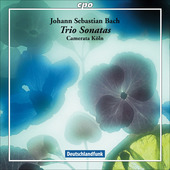J.s. Bach: Trio Sonatas (camerata Koln)
Label: CPO Catalog: 7773592 Format: CD If you share the view that Bach’s sonatas for flute and harpsichord are, together, an exercise in composing Baroque music in a bare bones way, then it might be helpful to think of the works on this recording as Bach’s layering onto the compositions BWV 1030, 1031, and 1032 more counterpoint and harmonic elements in his BWV 1027, 1028, and 1029. I’d like to think he was adding to: but, if you’d like to think of the process as boiling down, consider a wine-reduction sauce as your model. Either way, it is still Bach at about 35 years, more or less prime time for a composer. This may be some of his best work, and was originally intended for the organ. If you’d like, you might think of the lead instrument in these recordings as the organist’s right hand, the second lead as his left, and the basso continuo as the foot pedals. This CD represents a complement to Bach’s excellent sonatas for flute and harpsichord, reviewed elsewhere. Enter the Camerata Köln, a wonderful group of eight virtuoso musicians who can assemble in various combinations as needed. Steeped in the original-instruments tradition, they all play instruments that are (as near as possible) exact copies of instruments made in the 18th century (or thereabouts). They practice a kind of musicianship developed from performance manuals of that period. When manuscripts of the music of interest seem out of kilter, they study similar pieces, and they might add a section based on surviving Bach manuscripts that are intact. As we know, Bach himself did similar “cut and paste” exercises. So, what we have here are five trio sonatas, as they are called; except with the Camerata Köln they are not always a trio (strictly speaking), nor the same complement of instruments. That makes them vary in timbre if, say, the violin, flute, or recorder plays the lead; or if the viola da gamba or the violin plays the second lead; or if the bass viol, lute, or organ plays the continuo. Hence, they can be lighter or darker in hue, which, played in major or minor mode, can make for a very wide palette indeed. Interestingly, it brings to mind an image of an organist pulling out a different stop to change timbre. Musically, these five pieces do achieve a broader brush with which to paint, and paint very well. And the audio engineering is excellent. I think the audio surpasses that of an excellent performance recorded by The King’s Consort in 1996. Regarding over-all clarity, the industry in general and cpo in particular have improved a noticeable notch since then. It is gratifying to me to listen to this music late in the evening through a quality headphone rig. It seems to be “pure music,” with little reference to Bach’s religious music. As the trio sonatas are more varied than the flute sonatas, some people might like it more. I, Oblomov, can’t decide which I like better. Undecided, which is my fate, I’ll cop out and say, “They’re each terrific. Order them both!” FANFARE: Ilya Oblomov  Price: $25.98 Price: $25.98 |












